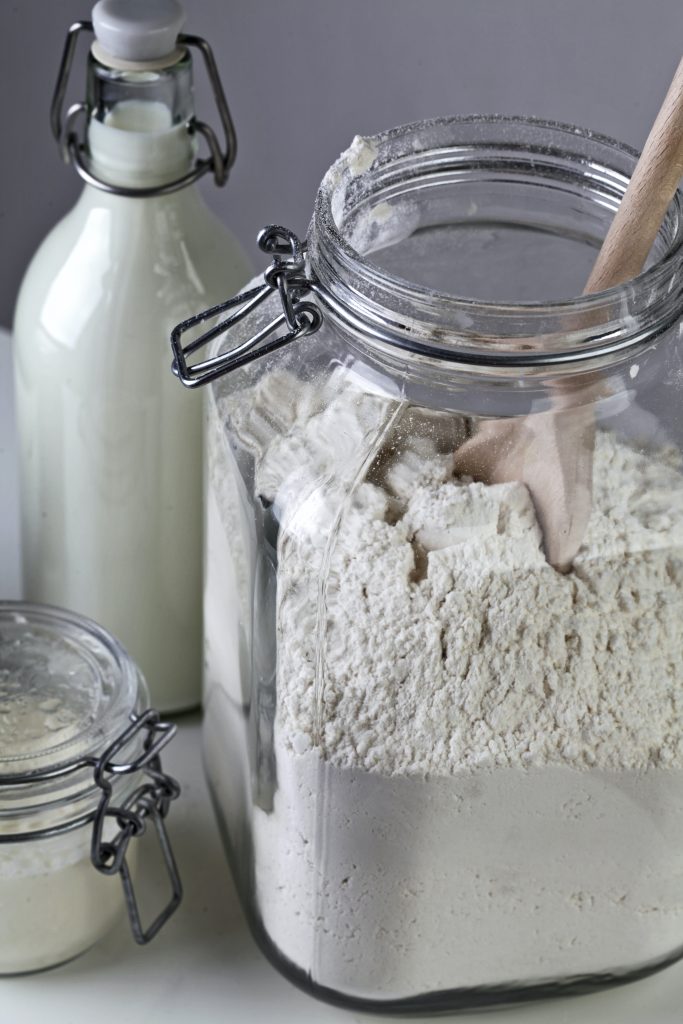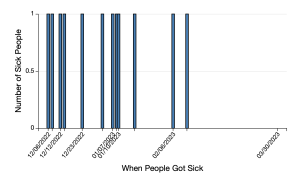All fields are required
Posted in Our Blog,Outbreaks & Recalls,Salmonella on March 30, 2023

UPDATE – The CDC has linked this Salmonella Flour Outbreak to Gold Medal Flour. You have likely already read our post about the dangers flour can present. In the past, we have seen flour and Ecoli in outbreaks. However, the CDC and FDA have announced another pathogen linked to a current flour outbreak – Salmonella. Here is everything we know about this latest Salmonella Flour Outbreak:
As of May 1, 2023, 13 people infected with the outbreak strain of Salmonella Infantis have been reported from 12 states (see map). Illnesses started on dates ranging from December 6, 2022, to March 1, 2023 (see timeline).
Public health officials collect many different types of information from sick people, including their age, race, ethnicity, other demographics, and the foods they ate in the week before they got sick. This information provides clues to help investigators identify the source of the outbreak.
Sick people range in age from 12 to 81 years, with a median age of 64, and 92% are female. Of 10 people with race or ethnicity information available, nine are White, one is Asian, and no one reported Hispanic ethnicity. Of 13 people with information available, three have been hospitalized. No deaths have been reported.
The true number of sick people in this outbreak is likely much higher than the number reported, and the outbreak may not be limited to the states with known illnesses. This is because many people recover without medical care and are not tested for Salmonella. In addition, recent illnesses may not yet be reported as it usually takes 3 to 4 weeks to determine if a sick person is part of an outbreak.
State and local public health officials are interviewing people about the foods they ate in the week before they got sick. Of the eight people interviewed, seven (88%) reported eating raw dough or batter. Of six sick people with brand information, all six (100%) reported buying Gold Medal brand flour. The only brand reported was Gold Medal.
FDA conducted a traceback investigation and identified a single production facility of the flour consumed by sick people. FDA initiated an inspection at the General Mills Kansas City, Missouri facility and collected samples from retain flour. The outbreak strain was identified in one of the samples of flour.
Whole genome sequencing analysis of bacteria from 13 people’s samples did not predict resistance to any antibiotics. Standard antibiotic susceptibility testing of one person’s sample by CDC’s National Antimicrobial Resistance Monitoring System (NARMS) laboratory also showed no resistance.
On April 28, 2023, General Mills voluntarily issued a nationwide recall of 2-pound, 5-pound, and 10-pound bags of Gold Medal Bleached and Unbleached All-Purpose Flour with “Better if Used By” dates of March 27, 2024, and March 28, 2024. The recalled products include the following Package Universal Product Codes (UPC):
| Recalled Product | Package UPC |
|---|---|
| Gold Medal Unbleached All-Purpose Flour (5 lb bag) | 000-16000-19610 |
| Gold Medal Unbleached All-Purpose Flour (10 lb bag) | 000-16000-19580 |
| Gold Medal Bleached All-Purpose Flour (2 lb bag) | 000-16000-10710 |
| Gold Medal Bleached All-Purpose Flour (5 lb bag) | 000-16000-10610 |
On April 28, 2023, General Mills voluntarily recalled 2-pound, 5-pound, and 10-pound bags of Gold Medal Bleached and Unbleached All-Purpose Flour with “Better if Used By” dates of March 27, 2024, and March 28, 2024. Two Product UPCs of Gold Medal Unbleached All-Purpose Flour in 5- and 10-pounds bags are affected, and two Product UPCs of Gold Medal Bleached All-Purpose Flour in 2- and 5-pound bags are affected. CDC advises you to throw away or return any bags of recalled flour and to wash any containers used to store recalled flour with warm water and soap.
CDC, public health and regulatory officials in several states, and the U.S. Food and Drug Administration (FDA) are collecting different types of data to identify the food source of a multistate outbreak of Salmonella Infantis infections.
Epidemiologic data show that flour contaminated with Salmonella is making people sick. Investigators are working to identify specific brands of flour that may be linked to these illnesses.
As of March 30, 2023, 12 people infected with the outbreak strain of Salmonella have been reported from 11 states. Illnesses started on dates ranging from December 6, 2022, to February 13, 2023.
Public health officials collect many different types of information from sick people, including their age, race, ethnicity, other demographics, and the foods they ate in the week before they got sick. This information provides clues to help investigators identify the source of the outbreak.
Sick people range in age from 12 to 81 years, with a median age of 64, and 92% are female. Of 10 people with race or ethnicity information available, 8 are White, 2 are Asian, and no one reported Hispanic ethnicity. Of 12 people with information available, 3 have been hospitalized. No deaths have been reported.

The true number of sick people in this outbreak is likely much higher than the number reported, and the outbreak may not be limited to the states with known illnesses. This is because many people recover without medical care and are not tested for Salmonella. In addition, recent illnesses may not yet be reported as it usually takes 3 to 4 weeks to determine if a sick person is part of an outbreak.
State and local public health officials are interviewing people about the foods they ate in the week before they got sick. Of the 7 people interviewed, 6 (86%) reported eating raw dough or batter. Flour was the only common ingredient in the raw dough or batter people reported eating. Investigators are working to identify a specific brand of raw flour that is linked to illnesses.
Public health investigators are using the PulseNet system to identify illnesses that may be part of this outbreak. CDC PulseNet manages a national database of DNA fingerprints of bacteria that cause foodborne illnesses. DNA fingerprinting is performed on bacteria using a method called whole genome sequencing (WGS).
WGS showed that bacteria from sick people’s samples are closely related genetically. This suggests that people in this outbreak may have gotten sick from eating the same food.
WGS analysis of bacteria from 12 people’s samples did not predict resistance to any antibiotics. Standard antibiotic susceptibility testing by CDC’s National Antimicrobial Resistance Monitoring System (NARMS) laboratory is currently underway.
Most people reported eating raw dough or batter made with flour before they got sick. Flour was the only common ingredient in the raw dough or batter people reported eating. Investigators are working to identify a specific brand of flour linked to illnesses.
According to the CDC, investigators are working to identify a specific brand of flour linked to this outbreak. However, any raw (unbaked) flour can have germs, like Salmonella. Do not eat or play with uncooked flour, dough, or batter.
Salmonella bacteria typically live in the intestines of humans and animals and are shed through feces. A common disease that affects the intestinal tract, humans usually become ill with Salmonella after consuming food or water contaminated with that feces.
Most people develop diarrhea, fever and abdominal cramps within eight to 72 hours. Most healthy people recover within a few days without specific treatment, but as usual with diarrhea, it’s important to drink plenty of fluids to avoid dehydration. In some cases, the diarrhea associated with Salmonella infection can be so dehydrating as to require prompt medical attention and can disrupt bowel habits for several months. Life-threatening complications also may develop if the infection spreads beyond your intestines, causing infection in urine, blood, bones, joints, or the nervous system, and can cause severe disease.
Some people with Salmonella infection develop pain in their joints, called reactive arthritis, after the infection has ended. Reactive arthritis can last for months or years and can be difficult to treat. Some people with reactive arthritis develop irritation of the eyes and pain when urinating.
Our mission is to help families who have been harmed by contaminated food or water. When corporations cause Salmonella food poisoning outbreaks, we use the law to hold them accountable. The Lange Law Firm is the only law firm in the nation solely focused on helping families in food poisoning lawsuits and contaminated water lawsuits.
If you got Salmonella food poisoning and are interested in making a legal claim for compensation in this Salmonella Flour Outbreak, we can help. Our Salmonella lawyer can help you pursue compensation for your Salmonella food poisoning. Call us for a free no obligation legal consultation at (833) 330-3663 or send us an e-mail here.